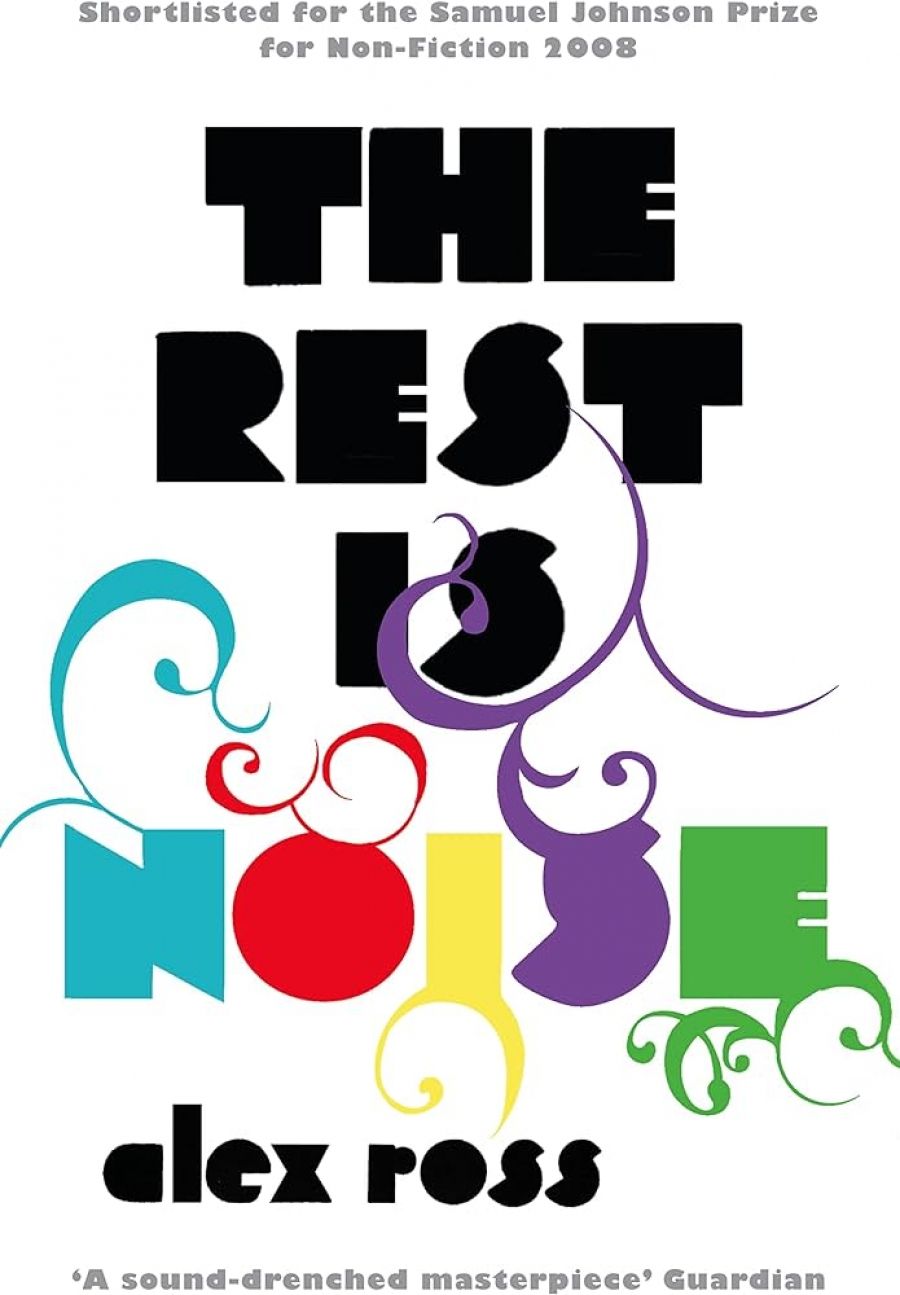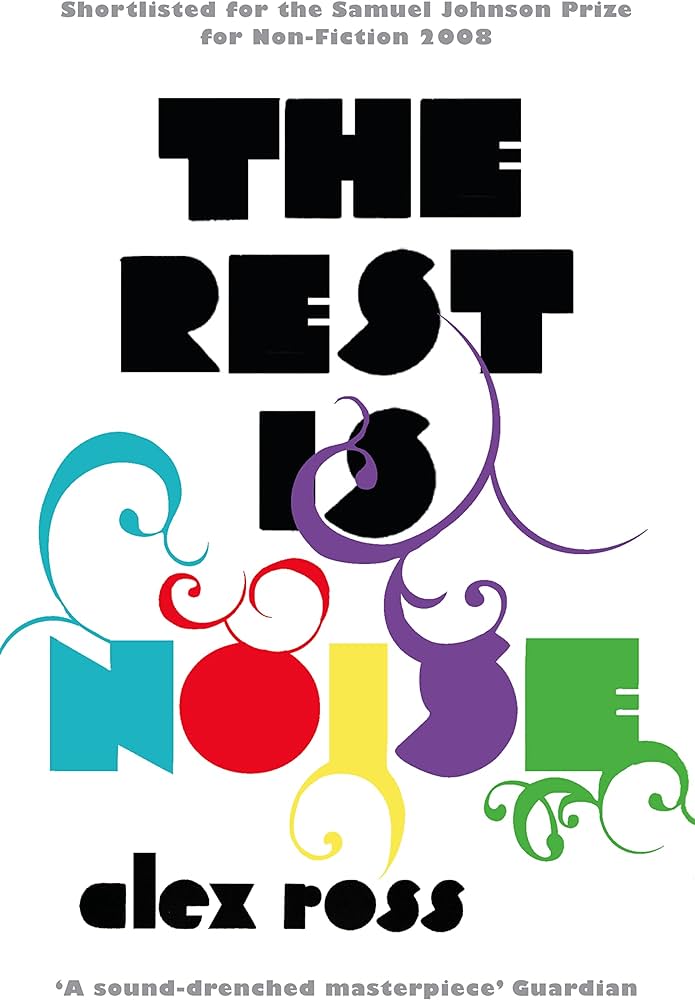
- Free Article: No
- Custom Article Title: High ideals
- Review Article: Yes
- Article Title: High ideals
- Online Only: No
- Custom Highlight Text:
Histories of classical music of whatever epoch – medieval, baroque, twentieth-century – tend to be written by university professors writing for a university readership. That being the case, they are issued by academic textbook publishers and are unlikely to pop up in your local bookstore. Chances are they won’t appear on best-seller and ‘pick of the critics’ lists.
- Book 1 Title: The Rest Is Noise
- Book 1 Subtitle: Listening to the Twentieth Century
- Book 1 Biblio: Farrar, Straus and Giroux, $59.95 hb, 624 pp
- Book 1 Cover Small (400 x 600):

- Book 1 Cover (800 x 1200):

Alex Ross’s The Rest Is Noise: Listening to the Twentieth Century is different. Stunningly different. Ross, still only forty, is music critic for The New Yorker, a post he has held since his late twenties. The Rest Is Noise is written in the same polished and eloquent style of the author’s pieces for that magazine (indeed, portions of the book appeared in different form in the pages of The New Yorker). Strictly speaking, Ross might be outside the academic music Establishment, but he commands the respect of musicological heavyweights, including Richard Taruskin at Berkeley and James Hepokoski at Yale. There are no footnotes in The Rest Is Noise, but Ross carefully documents his sources in fifty pages of closely written annotations. Miraculously, the book isn’t weighed down by its painstaking scholarship. It is fresh, lively and engaging. Which is not to say that it is music history-lite. Rather, it is music history as it should be: scrupulously researched, cogently argued and compellingly written. Not surprisingly, The Rest Is Noise was selected by The New York Times as one of the ten best books of 2007.
Pick up a standard history of twentieth-century classical music and odds are it will open with a few paragraphs on Debussy, Richard Strauss and Mahler, before launching into a discussion of the ‘historical necessity’ of Schoenberg’s ‘emancipation of the dissonance’. A detailed account of the twelve-tone music of Schoenberg, Webern and Berg will follow, and the rise of total serialism will be given full scrutiny. Stravinsky will occupy several pages (possibly a chapter) in the first half of the book; Cage will occupy a similar chunk in the second. Bartók, Shostakovich and Messiaen will be afforded walk-on parts. Boulez and Stockhausen will probably be given more substantial roles. The atomisation of the classical musical mainstream in the century’s third quarter will be discussed, and the book will most likely conclude with a chapter on minimalism.
All of the above-named composers and musical streams feature in Ross’s account, but the author is keen to tell us more. A lot more. For Ross, twentieth-century classical music is bigger than the modernist and avant-garde narratives outlined above. It embraces Gershwin, Copland, Sibelius, Britten and Bernstein amongst others. One of the most surprising aspects of The Rest Is Noise is the prominence granted Richard Strauss. Conventional histories of twentieth-century classical music tend to dismiss as ‘irrelevant’ Strauss’s works after the violent and dissonant Elektra of 1908. Der Rosenkavalier in 1910 – with its Viennese waltzes and cleaned-up harmonies – is said to mark Strauss’s exit from the twentieth-century; which is strange, given that the composer lived until 1949. Ross’s book must be the only history of twentieth-century music that admits the Four Last Songs.
The Rest Is Noise commences with the Austrian première of Strauss’s Salome in Graz, in 1906. Not only was the composer present (he conducted), but Mahler, Puccini, Schoenberg, Berg, Zemlinsky and, possibly, the young Adolf Hitler were also in attendance. As Ross points out, ‘there was even a fictional character present – Adrian Leverkühn, the hero of Thomas Mann’s Doctor Faustus, the tale of a composer in league with the devil’. The conjunction of so many personalities (whether real or fictional) at the Graz Salome provides Ross with themes and motifs that are explored, embellished and recapitulated throughout much of The Rest Is Noise. The title of the book may tweak Hamlet’s dying gasp, but it is Mann’s Doctor Faustus (1947) that casts its shadow over much of what follows.
Mann’s novel is informed by twentieth-century politics, and so is Ross’s chronicle. Rather than being described as a history of twentieth-century music, The Rest Is Noise might more accurately be said to be a history of the twentieth century through its music. One reason why Strauss doesn’t drop out of the narrative is that he held the post of president of the chamber of music during the early years of the Third Reich and remained in either Germany or Austria throughout World War II. The story of the Soviet Union is told through the music of two of its greatest composers, Shostakovich and Prokofiev; and Copland’s music is examined within the context of Roosevelt’s New Deal. It is fascinating to learn that Copland did not have an easy time in the early Cold War period thanks to his affinity with the New Deal’s quasi-socialist principles. Copland’s ‘wholesomeness’ – he is the composer of Fanfare for the Common Man and Appalachian Spring – did not put him in good stead with American Cold War politics. The CIA, meanwhile, was showering money on avant-garde music festivals in 1950s Europe. As Ross points out in a sophisticated and nuanced analysis of music in the Third Reich, ‘the automatic equation of radical style with liberal politics and of conservative style with reactionary politics is a historical myth that does little justice to an agonizingly ambiguous historical reality’.
Among Ross’s many gifts is the rare ability to describe a musical phrase or passage accurately and poetically without overloading his prose with jargon and terminology drawn from music theory. This is a book for laymen and scholars alike. Here he is on the clarinet solo at the start of Gershwin’s Rhapsody in Blue:
The score famously begins with a languid trill on the clarinet, which turns into an equally languid upward scale, which then becomes a super-elegant and not at all raucous glissando. Having reached the topmost B-flat, the clarinet then saunters through a lightly syncopated melody, leaning heavily on the lowered seventh note of the scale. The tune dances down the same staircase that the opening scale shimmied up, ending on the F with which the piece began – a typical Gershwin symmetry.
In addition to telling you what’s on the printed page of music – trill, top B-flat, F – Ross describes the experience of listening to the passage while also drawing your attention to its jazz-age elegance and sophistication. Time and again, Ross delivers these kinds of beautifully encapsulated accounts. Sometimes his metaphors are a little florid, but their purpose is to illuminate in words something which is delivered in sound.
Ross is incapable of writing a boring sentence and is a master of sharp and often witty turns of phrase. In discussing the fashion for ‘Negro’ jazz in 1920s Paris, he points out that there is no need to belabour the fact that le jazz – the local take on the exotic import – was ‘condescending towards its African-American sources’: ‘Cocteau and Poulenc were enjoying a one-night stand with a dark-skinned form, and they had no intention of striking up a conversation the following day.’ In his survey of current new music, he notes that composers in Germany and Austria – unlike their counterparts in the United States, for instance – remain committed to high modernist ideals and are wary of producing audience-friendly sounds. This is perhaps not surprising, given music’s role in the Nazi terror. As Ross puts it, ‘The great German tradition, with all its grandeurs and sorrows, is cordoned off, like a crime scene under investigation.’
Ross’s narrative is at its best when it deals with the grandeurs and sorrows of the twentieth century. If the final third of the book, which covers the century’s closing decades, is less engrossing than the preceding parts, it might be on account of the proximity of our own time to the people and events under discussion. As works, movements and composers recede further into the past, they come into sharper focus and offer perspectives that only the passing of time can generate.
While reading The Rest is Noise, I frequently put it to one side and listened to recordings of twentieth-century works I hadn’t heard for a long, long time; music by Weill, Stravinsky, Sibelius, Ravel and Messiaen. Ross’s book is like that. It will invite you to engage – or re-engage – with the music and events of a marvellous, terrible century.


Comments powered by CComment